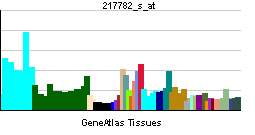GPS1
| G protein pathway suppressor 1 | |||||||||||
|---|---|---|---|---|---|---|---|---|---|---|---|
| Identifiers | |||||||||||
| Symbols | GPS1 ; CSN1; COPS1; MGC71287 | ||||||||||
| External IDs | Template:OMIM5 Template:MGI HomoloGene: 3046 | ||||||||||
| |||||||||||
| RNA expression pattern | |||||||||||
 | |||||||||||
| More reference expression data | |||||||||||
| Orthologs | |||||||||||
| Template:GNF Ortholog box | |||||||||||
| Species | Human | Mouse | |||||||||
| Entrez | n/a | n/a | |||||||||
| Ensembl | n/a | n/a | |||||||||
| UniProt | n/a | n/a | |||||||||
| RefSeq (mRNA) | n/a | n/a | |||||||||
| RefSeq (protein) | n/a | n/a | |||||||||
| Location (UCSC) | n/a | n/a | |||||||||
| PubMed search | n/a | n/a | |||||||||
G protein pathway suppressor 1, also known as GPS1, is a human gene.[1]
This gene is known to suppress G-protein and mitogen-activated signal transduction in mammalian cells. The encoded protein shares significant similarity with Arabidopsis FUS6, which is a regulator of light-mediated signal transduction in plant cells. Two alternatively spliced transcript variants encoding different isoforms have been found for this gene.[1]
References
Further reading
- Wolf DA, Zhou C, Wee S (2004). "The COP9 signalosome: an assembly and maintenance platform for cullin ubiquitin ligases?". Nat. Cell Biol. 5 (12): 1029–33. doi:10.1038/ncb1203-1029. PMID 14647295.
- Maruyama K, Sugano S (1994). "Oligo-capping: a simple method to replace the cap structure of eukaryotic mRNAs with oligoribonucleotides". Gene. 138 (1–2): 171–4. PMID 8125298.
- Spain BH, Bowdish KS, Pacal AR; et al. (1997). "Two human cDNAs, including a homolog of Arabidopsis FUS6 (COP11), suppress G-protein- and mitogen-activated protein kinase-mediated signal transduction in yeast and mammalian cells". Mol. Cell. Biol. 16 (12): 6698–706. PMID 8943324.
- Suzuki Y, Yoshitomo-Nakagawa K, Maruyama K; et al. (1997). "Construction and characterization of a full length-enriched and a 5'-end-enriched cDNA library". Gene. 200 (1–2): 149–56. PMID 9373149.
- Seeger M, Kraft R, Ferrell K; et al. (1998). "A novel protein complex involved in signal transduction possessing similarities to 26S proteasome subunits". FASEB J. 12 (6): 469–78. PMID 9535219.
- Wei N, Tsuge T, Serino G; et al. (1998). "The COP9 complex is conserved between plants and mammals and is related to the 26S proteasome regulatory complex". Curr. Biol. 8 (16): 919–22. PMID 9707402.
- Tsuge T, Matsui M, Wei N (2001). "The subunit 1 of the COP9 signalosome suppresses gene expression through its N-terminal domain and incorporates into the complex through the PCI domain". J. Mol. Biol. 305 (1): 1–9. doi:10.1006/jmbi.2000.4288. PMID 11114242.
- Bech-Otschir D, Kraft R, Huang X; et al. (2001). "COP9 signalosome-specific phosphorylation targets p53 to degradation by the ubiquitin system". EMBO J. 20 (7): 1630–9. doi:10.1093/emboj/20.7.1630. PMID 11285227.
- Lyapina S, Cope G, Shevchenko A; et al. (2001). "Promotion of NEDD-CUL1 conjugate cleavage by COP9 signalosome". Science. 292 (5520): 1382–5. doi:10.1126/science.1059780. PMID 11337588.
- Hoareau Alves K, Bochard V, Réty S, Jalinot P (2002). "Association of the mammalian proto-oncoprotein Int-6 with the three protein complexes eIF3, COP9 signalosome and 26S proteasome". FEBS Lett. 527 (1–3): 15–21. PMID 12220626.
- Sun Y, Wilson MP, Majerus PW (2003). "Inositol 1,3,4-trisphosphate 5/6-kinase associates with the COP9 signalosome by binding to CSN1". J. Biol. Chem. 277 (48): 45759–64. doi:10.1074/jbc.M208709200. PMID 12324474.
- Strausberg RL, Feingold EA, Grouse LH; et al. (2003). "Generation and initial analysis of more than 15,000 full-length human and mouse cDNA sequences". Proc. Natl. Acad. Sci. U.S.A. 99 (26): 16899–903. doi:10.1073/pnas.242603899. PMID 12477932.
- Serino G, Su H, Peng Z; et al. (2003). "Characterization of the last subunit of the Arabidopsis COP9 signalosome: implications for the overall structure and origin of the complex". Plant Cell. 15 (3): 719–31. PMID 12615944.
- Uhle S, Medalia O, Waldron R; et al. (2003). "Protein kinase CK2 and protein kinase D are associated with the COP9 signalosome". EMBO J. 22 (6): 1302–12. doi:10.1093/emboj/cdg127. PMID 12628923.
- Groisman R, Polanowska J, Kuraoka I; et al. (2003). "The ubiquitin ligase activity in the DDB2 and CSA complexes is differentially regulated by the COP9 signalosome in response to DNA damage". Cell. 113 (3): 357–67. PMID 12732143.
- Ota T, Suzuki Y, Nishikawa T; et al. (2004). "Complete sequencing and characterization of 21,243 full-length human cDNAs". Nat. Genet. 36 (1): 40–5. doi:10.1038/ng1285. PMID 14702039.
- Wang Y, Lu C, Wei H; et al. (2004). "Hepatopoietin interacts directly with COP9 signalosome and regulates AP-1 activity". FEBS Lett. 572 (1–3): 85–91. doi:10.1016/j.febslet.2004.07.012. PMID 15304329.
- Gerhard DS, Wagner L, Feingold EA; et al. (2004). "The status, quality, and expansion of the NIH full-length cDNA project: the Mammalian Gene Collection (MGC)". Genome Res. 14 (10B): 2121–7. doi:10.1101/gr.2596504. PMID 15489334.
- Beausoleil SA, Villén J, Gerber SA; et al. (2006). "A probability-based approach for high-throughput protein phosphorylation analysis and site localization". Nat. Biotechnol. 24 (10): 1285–92. doi:10.1038/nbt1240. PMID 16964243.
| This protein-related article is a stub. You can help Wikipedia by expanding it. |